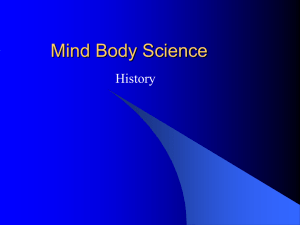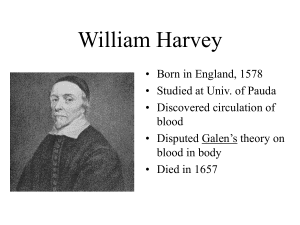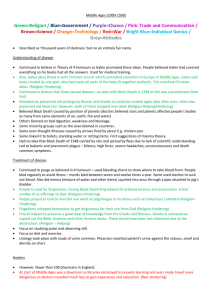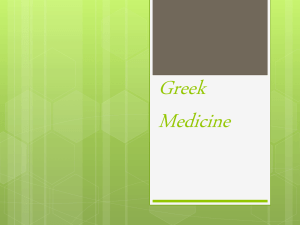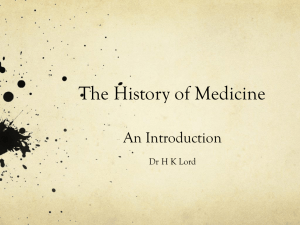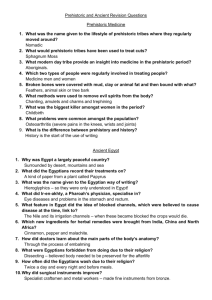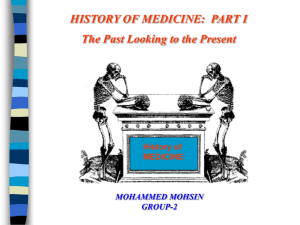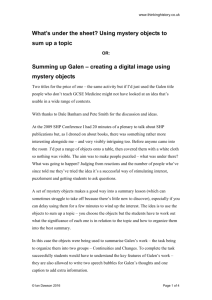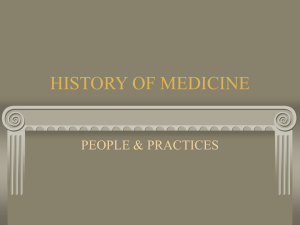Medicine in the Medieval Period
advertisement
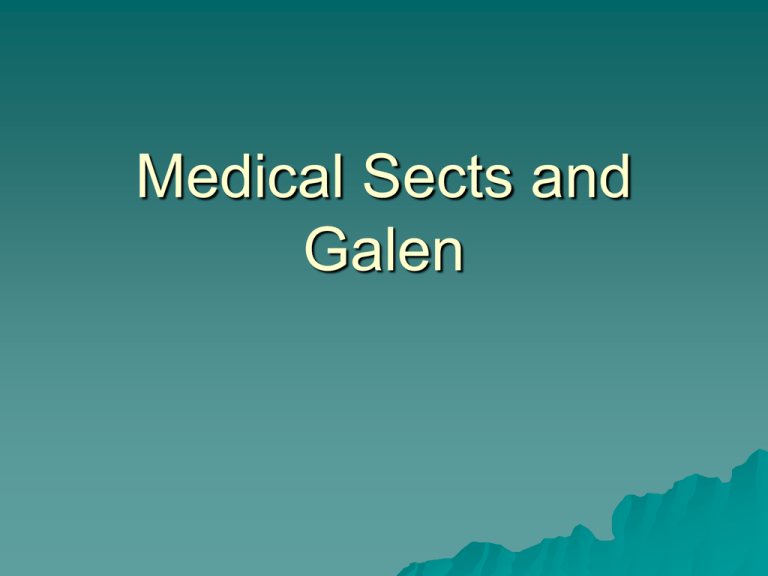
Medical Sects and Galen Tensions in Ancient Medicine Rationalists Hippocratics Theory guided medical practice Speculative Humoural theory Anatomy & Physiology Empiricists Medical knowledge gained by experience Training in the art of observation Empiricist medicine still an art Still separated medicine from other healers Apprenticeship model of medical education persisted until 19th century Rise of the Methodists (1st Century CE) Challenged both Rationalist and Empiricist medicine All illness result of either constriction or dilation of pores of body Denied the learned basis of medicine Anyone could learn medicine in 6 months Thumbing Noses at Learned Medicine Hippocrates: Life is short, the art long, opportunity fleeting, experiment dangerous and judgment difficult Methodists: Life is long and the art is short. Galen of Pergamon (129-c.219 CE) Born in what is now Turkey Son of an architect Began medical studies at age 16 Studied in Alexandria Travelled widely in Egypt Began medical practice in late 20s Physician to the gladiators in Pergamon Moved to Rome Gained fame for – Public anatomical displays – His philosophical acumen – His successful medical treatments of the elite Why – He – He – He – He was Galen successful? was was was was a a a a Roman citizen member of the elite shameless self-promoter prolific writer The Context of Galen’s Practice Regarded himself as Hippocrates’ heir In some ways, he invented Hippocrates Loathed the Methodists Systematized Believed universe Believed Hippocratic medicine in a divinely ordered it could only be discerned through reason and intellect Elaborating Hippocrates Extended the humoural theory Believed it confirmed Plato’s tripartite human soul – Liver (nutrition) – Heart (vitality) – Brain (reason/sensation) Humoural theory also extended Aristotelian physics – Four – Four – Four – Four humours elements seasons primary qualities Galen’s Innovations: Nosology Classification of diseases Diagnosis Prognosis Diseases are specific entities, not malleable Galen’s Contributions Experimentation Groundbreaking work in anatomy & physiology Existence of psychosomatic disease Belief in primacy of reason Diminished the work of those he disagreed with Plagiarized the work of those he did agree with Medieval Medicine (c. 400- 1000 BCE) Split in Roman Empire – 4th century BCE Eastern Empire – Byzantine – Greek speaking – Centred in Constantinople (now Istanbul) Constantinople century Empire sacked in 14th reduced to city & its hinterland Western – Latin speaking – Centred in Rome Rome sacked in 410 CE Political, social, & economic chaos De-urbanization – Return to agricultural economy Loss of trade relationships Loss of traditional ways of transmitting knowledge – Decline in intellectual life – No centres of higher learning – Few masters training apprentices in medicine Often referred to as the “Dark Ages” Result was 2 types of medical literature 1.Latin – Encyclopedia – commentary 2.Vernacular – Written by lay people – e.g.: Old English (Anglo Saxon) texts – Date from 10th century Leechbook of Bald Lacnunga Non theoretical Drawn from diverse sources Indications of pre-Christian traditions – Magic Overlaid with Christian elements Impact of rise of Christianity – Issues of adjustment between “pagan” & Christian thought 1.Intellectual – What causes disease – What cures disease 2.Practical – Healing institutions Healing shrines Hospices Monasteries Medicine in Islam Or How the East Saved Western Medicine Important Variables Former Greek Political Greek Eastern Roman empire spoke stability speaking physicians from the old eastern empire moved further east Islamic Empire Mohammed After (d. 632 C.E.) his death, new faith spread rapidly in Arabian peninsula By 642 C.E.: – – – – Armenia Mesopotamia Much of Persia Much of Egypt By 743 C.E.: – – – – – – North Africa Much of Spain Almost France Persia Kashmir Punjab The Islamic World c. 730 C.E. The Islamic Intellectual World Centred in Bagdad Presence of Greek speaking intellectuals Sponsored by Islamic court Translations of Greek medical texts Muslim intellectuals drawn to rigour of Greek philosophy & medicine 100 texts by Galen translated Muslim intellectuals sought to build on the work already done Both faithful to Greek/Roman traditions & innovative Integrated their own knowledge of remedies Advances in surgical procedures Rhazes (865-925 C.E.) Differentiated measles between small pox and Much more difficult than it may appear Other Muslim physicians described person-to-person spread of disease Ibn Sina (Avicenna) 980-1037 C.E. Distinguished between episodic diseases and epidemics Believed air was the principal vehicle for spreading disease Also, “evil eye” Later Western Medicine’s Assessment of Islamic Medicine Described Unfair as unoriginal on several counts – Great respect for tradition – Difficulties associated with translation Islamic Medicine’s Legacy Preserved and advanced early western medicine Avicenna – Prolific writer – The Cannon – Became known as the “Galen of Islam” Spain under Muslim Rule Important site for re-entry of ancient medicine into medieval Europe Contribution of Spanish Jews – Moses Maimonides Philosopher & physician Guide for the Perplexed
